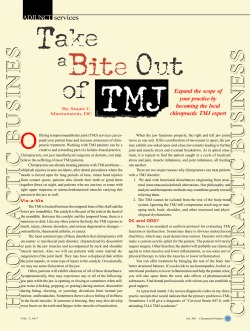
Temporomandibular Disorders Information for patients
Temporomandibular Disorders Information for patients What are the temporomandibular joints (TMJs) • The TMJs are the most complex joints in the body. • They are located on either side of the head between the lower jaw and skull. • These are the joints that open and close the jaw. • They are essential for chewing and are the most frequently used joints in the body. What is TMD? This is a common, painful condition which frequently gets better of its own accord. It is sometimes called facial arthromyalgia (FAM) or temporomandibular joint dysfunction (TMJD) and causes pain affecting the temporomandibular joint (TMJ) and/or the surrounding muscles. Who gets TMD? • It most commonly affects young adults, but can occur in children and older people. • Women may be slightly more likely to suffer from it than men. • It may occur in people who have a tooth grinding or jaw clenching habit. • It may occur when people are stressed or anxious – for example when studying for exams, moving house, or starting a new job. • It may also affect those in certain occupations, where it is necessary to talk frequently or hold the jaw in an awkward position – for example musicians. Features of TMD People who have TMD may notice: • Clicking or grinding noises coming from one or both of their jaw joints when they open or close their mouth. • Pain, discomfort or tenderness of the jaw joints and surrounding muscles. • The pain is usually a dull ache, but may be sharp and occur suddenly. • Locking of the jaw on opening. • Reduced opening of the mouth. • Earache, buzzing or a feeling of ‘fullness’ in the ear. • Headache or dizziness. • Neck ache. • Other bodily pains, for example backache. • Sleep disturbance. What causes TMD? • Many causes have been suggested and may include past injury of the joint or muscles. • Stress does not cause TMD, but can increase levels of pain. • It may be helpful to think of it as a ‘cramp’ of the muscles. • Clicking noises indicate altered movement of the disc, but not damage of the jaw bone. • Bone damage to the joint does not usually occur except in arthritis of the jaw. When does TMD get better? • TMD is usually a temporary discomfort. • It sometimes clears up when pain-provoking activities or events have resolved. • TMD is rarely a sign of serious disease. • Most patients find the pain from TMD improves without complex treatment. • Naturally it can be worrying to experience pain and stiffness. This can sometimes lead to thoughts that there is damage to the joint, that the pain may get worse or that the jaw may lock. These negative thoughts can create anxiety and tension. It can be helpful therefore to try to learn ways of managing TMD described in this leaflet. How to manage a flare-up? Some people may experience a few days or weeks of severe pain and / or limited mouth opening. During this time try to: • Eat a soft diet and use both sides at the same time or alternate sides. • Chew with your back teeth rather than biting with your front teeth. • Avoid activities that involve wide opening of the jaw, e.g. yawning or prolonged dental treatments, until the pain has reduced. • Avoid oral habits that put a strain on jaw muscles and joints, e.g. chewing objects, jaw clenching. • Apply moist heat or cold (whichever feels better). Use for 10-20 minutes three or four times a day. For example, heat a wet towel in a microwave for one minute until it is warm or wrap ice in a thin face towel and apply for no more than five minutes. • Keeping your tongue up in the roof of your mouth and teeth apart means the jaw muscles are in a relaxed position. • Painrelievers may help (providing there is no medical reason why these cannot be taken). • A soft plastic bite guard to cover the teeth may sometimes be made by your dentist to prevent you clenching too hard. • Learn and practise daily relaxation including abdominal breathing. • Ensure you get a good night’s sleep. What to do when flare-up of pain subsides Once the severe episode has settled it is important to return to normal jaw activity. Jaw muscles need to be used to keep them strong and flexible. • Try to get back to eating a full range of foods. Gradually reintroduce harder foods to allow the muscles to adjust. • Identify and avoid activities and events that cause flare-ups. • Maintain a regular relaxation routine. When is a referral to a specialist clinic needed? • Pain persists or increases in severity. • Symptoms do not respond to suggested treatments. • Opening of the mouth becomes limited. What treatment may be considered at the specialist centre? • Jaw exercises and bite guards. • Medication including antidepressants, used for pain relief. • Referral to a Facial Pain Management service. • Referral for investigation of the joint. For further information Please see Temporomandibular Joint Disorders at www.patient.co.uk How to contact us If you have any concerns or questions, please contact: Department of Oral & Maxillofacial Surgery and Orthodontics The John Radcliffe Hospital Headley Way, Headington, Oxford, OX3 9DU Tel: 01865 221407 c he Fa in r Fax: 01865 222040 et gP a i n To g Image reproduced with kind permission from Patricia Chatlin If you need an interpreter or need a document in another language, large print, Braille or audio version, please call 01865 221473 or email PALSJR@orh.nhs.uk Update approved by Miss Daljit K Dhariwal, Consultant in Oral and Maxillofacial Surgery Version 2, February 2011 Review, February 2014 Oxford Radcliffe Hospitals NHS Trust Oxford OX3 9DU www.oxfordradcliffe.nhs.uk/patientinformation OMI 2869
© Copyright 2025





















